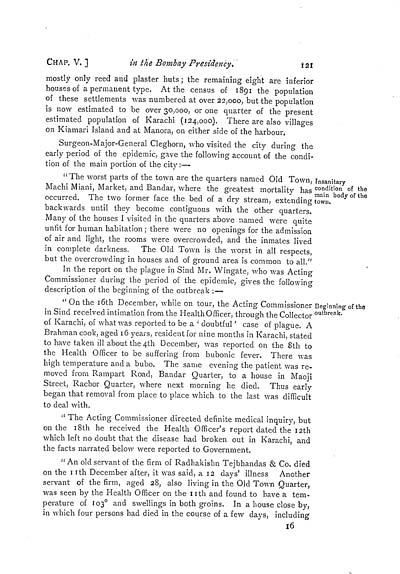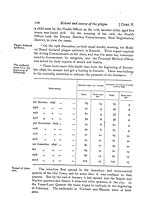Medicine - Disease > Plague in India, 1896, 1897 > Volume 1
(142) Page 121
Download files
Individual page:
Thumbnail gallery: Grid view | List view

CHAP. V. ] in the Bombay Presidency. 121
mostly only reed and plaster huts; the remaining eight are inferior
houses of a permanent type. At the census of 1891 the population
of these settlements was numbered at over 22,000, but the population
is now estimated to be over 30,000, or one quarter of the present
estimated population of Karachi (124,000). There are also villages
on Kiamari Island and at Manora, on either side of the harbour.
Surgeon-Major-General Cleghorn, who visited the city during the
early period of the epidemic, gave the following account of the condi-
tion of the main portion of the city:-
Insanitary
condition of the
main body of the
town.
"The worst parts of the town are the quarters named Old Town,
Machi Miani, Market, and Bandar, where the greatest mortality has
occurred. The two former face the bed of a dry stream, extending
backwards until they become contiguous with the other quarters.
Many of the houses I visited in the quarters above named were quite
unfit for human habitation; there were no openings for the admission
of air and light, the rooms were overcrowded, and the inmates lived
in complete darkness. The Old Town is the worst in all respects,
but the overcrowding in houses and of ground area is common to all."
In the report on the plague in Sind Mr. Wingate, who was Acting
Commissioner during the period of the epidemic, gives the following
description of the beginning of the outbreak:-
Beginning of the
outbreak.
"On the 16th December, while on tour, the Acting Commissioner
in Sind received intimation from the Health Officer, through the Collector
of Karachi, of what was reported to be a 'doubtful ' case of plague. A
Brahman cook, aged 16 years, resident for nine months in Karachi, stated
to have taken ill about the 4th December, was reported on the 8th to
the Health Officer to be suffering from bubonic fever. There was
high temperature and a bubo. The same evening the patient was re-
moved from Rampart Road, Bandar Quarter, to a house in Maoji
Street, Rachor Quarter, where next morning he died. Thus early
began that removal from place to place which to the last was difficult
to deal with.
"The Acting Commissioner directed definite medical inquiry, but
on the 18th he received the Health Officer's report dated the I2th
which left no doubt that the disease had broken out in Karachi, and
the facts narrated below were reported to Government.
"An old servant of the firm of Radhakishn Tejbhandas & Co. died
on the 11th December after, it was said, a 12 days' illness Another
servant of the firm, aged 28, also living in the Old Town Quarter,
was seen by the Health Officer on the 11th and found to have a tem-
perature of 103 and swellings in both groins. In a house close by,
in which four persons had died in the course of a few days, including
16
mostly only reed and plaster huts; the remaining eight are inferior
houses of a permanent type. At the census of 1891 the population
of these settlements was numbered at over 22,000, but the population
is now estimated to be over 30,000, or one quarter of the present
estimated population of Karachi (124,000). There are also villages
on Kiamari Island and at Manora, on either side of the harbour.
Surgeon-Major-General Cleghorn, who visited the city during the
early period of the epidemic, gave the following account of the condi-
tion of the main portion of the city:-
Insanitary
condition of the
main body of the
town.
"The worst parts of the town are the quarters named Old Town,
Machi Miani, Market, and Bandar, where the greatest mortality has
occurred. The two former face the bed of a dry stream, extending
backwards until they become contiguous with the other quarters.
Many of the houses I visited in the quarters above named were quite
unfit for human habitation; there were no openings for the admission
of air and light, the rooms were overcrowded, and the inmates lived
in complete darkness. The Old Town is the worst in all respects,
but the overcrowding in houses and of ground area is common to all."
In the report on the plague in Sind Mr. Wingate, who was Acting
Commissioner during the period of the epidemic, gives the following
description of the beginning of the outbreak:-
Beginning of the
outbreak.
"On the 16th December, while on tour, the Acting Commissioner
in Sind received intimation from the Health Officer, through the Collector
of Karachi, of what was reported to be a 'doubtful ' case of plague. A
Brahman cook, aged 16 years, resident for nine months in Karachi, stated
to have taken ill about the 4th December, was reported on the 8th to
the Health Officer to be suffering from bubonic fever. There was
high temperature and a bubo. The same evening the patient was re-
moved from Rampart Road, Bandar Quarter, to a house in Maoji
Street, Rachor Quarter, where next morning he died. Thus early
began that removal from place to place which to the last was difficult
to deal with.
"The Acting Commissioner directed definite medical inquiry, but
on the 18th he received the Health Officer's report dated the I2th
which left no doubt that the disease had broken out in Karachi, and
the facts narrated below were reported to Government.
"An old servant of the firm of Radhakishn Tejbhandas & Co. died
on the 11th December after, it was said, a 12 days' illness Another
servant of the firm, aged 28, also living in the Old Town Quarter,
was seen by the Health Officer on the 11th and found to have a tem-
perature of 103 and swellings in both groins. In a house close by,
in which four persons had died in the course of a few days, including
16
Set display mode to: Large image | Zoom image | Transcription
Images and transcriptions on this page, including medium image downloads, may be used under the Creative Commons Attribution 4.0 International Licence unless otherwise stated. ![]()
| India Papers > Medicine - Disease > Plague in India, 1896, 1897 > Volume 1 > (142) Page 121 |
|---|
| Permanent URL | https://digital.nls.uk/74593976 |
|---|---|




